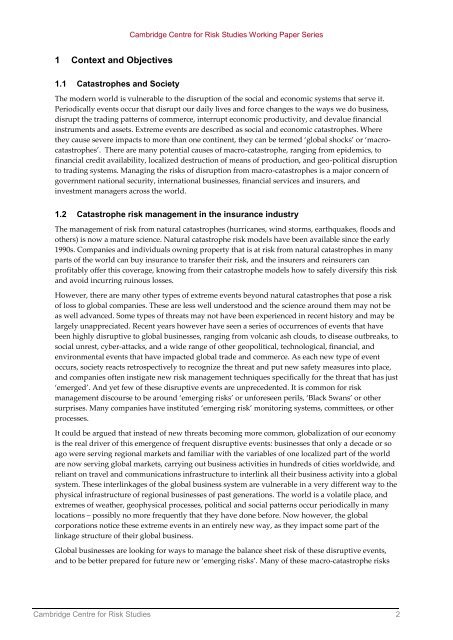A Taxonomy of Threats for Macro-Catastrophe Risk Management
A Taxonomy of Threats for Macro-Catastrophe Risk Management
A Taxonomy of Threats for Macro-Catastrophe Risk Management
You also want an ePaper? Increase the reach of your titles
YUMPU automatically turns print PDFs into web optimized ePapers that Google loves.
Cambridge Centre <strong>for</strong> <strong>Risk</strong> Studies Working Paper Series1 Context and Objectives1.1 <strong>Catastrophe</strong>s and SocietyThe modern world is vulnerable to the disruption <strong>of</strong> the social and economic systems that serve it.Periodically events occur that disrupt our daily lives and <strong>for</strong>ce changes to the ways we do business,disrupt the trading patterns <strong>of</strong> commerce, interrupt economic productivity, and devalue financialinstruments and assets. Extreme events are described as social and economic catastrophes. Wherethey cause severe impacts to more than one continent, they can be termed ‘global shocks’ or ‘macrocatastrophes’.There are many potential causes <strong>of</strong> macro-catastrophe, ranging from epidemics, t<strong>of</strong>inancial credit availability, localized destruction <strong>of</strong> means <strong>of</strong> production, and geo-political disruptionto trading systems. Managing the risks <strong>of</strong> disruption from macro-catastrophes is a major concern <strong>of</strong>government national security, international businesses, financial services and insurers, andinvestment managers across the world.1.2 <strong>Catastrophe</strong> risk management in the insurance industryThe management <strong>of</strong> risk from natural catastrophes (hurricanes, wind storms, earthquakes, floods andothers) is now a mature science. Natural catastrophe risk models have been available since the early1990s. Companies and individuals owning property that is at risk from natural catastrophes in manyparts <strong>of</strong> the world can buy insurance to transfer their risk, and the insurers and reinsurers canpr<strong>of</strong>itably <strong>of</strong>fer this coverage, knowing from their catastrophe models how to safely diversify this riskand avoid incurring ruinous losses.However, there are many other types <strong>of</strong> extreme events beyond natural catastrophes that pose a risk<strong>of</strong> loss to global companies. These are less well understood and the science around them may not beas well advanced. Some types <strong>of</strong> threats may not have been experienced in recent history and may belargely unappreciated. Recent years however have seen a series <strong>of</strong> occurrences <strong>of</strong> events that havebeen highly disruptive to global businesses, ranging from volcanic ash clouds, to disease outbreaks, tosocial unrest, cyber-attacks, and a wide range <strong>of</strong> other geopolitical, technological, financial, andenvironmental events that have impacted global trade and commerce. As each new type <strong>of</strong> eventoccurs, society reacts retrospectively to recognize the threat and put new safety measures into place,and companies <strong>of</strong>ten instigate new risk management techniques specifically <strong>for</strong> the threat that has just‘emerged’. And yet few <strong>of</strong> these disruptive events are unprecedented. It is common <strong>for</strong> riskmanagement discourse to be around ‘emerging risks’ or un<strong>for</strong>eseen perils, ‘Black Swans’ or othersurprises. Many companies have instituted ‘emerging risk’ monitoring systems, committees, or otherprocesses.It could be argued that instead <strong>of</strong> new threats becoming more common, globalization <strong>of</strong> our economyis the real driver <strong>of</strong> this emergence <strong>of</strong> frequent disruptive events: businesses that only a decade or soago were serving regional markets and familiar with the variables <strong>of</strong> one localized part <strong>of</strong> the worldare now serving global markets, carrying out business activities in hundreds <strong>of</strong> cities worldwide, andreliant on travel and communications infrastructure to interlink all their business activity into a globalsystem. These interlinkages <strong>of</strong> the global business system are vulnerable in a very different way to thephysical infrastructure <strong>of</strong> regional businesses <strong>of</strong> past generations. The world is a volatile place, andextremes <strong>of</strong> weather, geophysical processes, political and social patterns occur periodically in manylocations – possibly no more frequently that they have done be<strong>for</strong>e. Now however, the globalcorporations notice these extreme events in an entirely new way, as they impact some part <strong>of</strong> thelinkage structure <strong>of</strong> their global business.Global businesses are looking <strong>for</strong> ways to manage the balance sheet risk <strong>of</strong> these disruptive events,and to be better prepared <strong>for</strong> future new or ‘emerging risks’. Many <strong>of</strong> these macro-catastrophe risksCambridge Centre <strong>for</strong> <strong>Risk</strong> Studies 2


